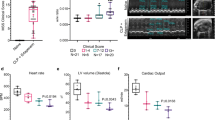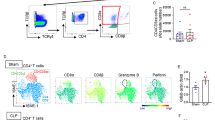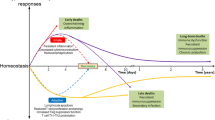Abstract
Leukocyte apoptosis is an energy-dependent process that facilitates resolution of the cellular inflammatory response. Levels of apoptosis can be accelerated or inhibited after exposure to various stimuli. To compare apoptosis in transmigrated leukocytes, two models of peritonitis in mice were used that both cause leukocyte influx into the peritoneal cavity: (1) intraperitoneal thioglycollate administration producing a sterile peritonitis and (2) cecal ligation and puncture (CLP) producing a polymicrobial bacterial peritonitis. Samples of blood and peritoneal exudate cells (PEC) were collected at multiple time points after induction of peritonitis. Leukocytes were either fixed immediately to determine an immediate apoptosis level or cultured for 24 h to determine a delayed apo- ptosis level. Apoptosis was assessed using terminal uridine-triphosphate nick-end labeling (TUNEL) assay, flow cytometry, and confocal microscopy. Leukocyte influx into the peritoneal cavity was confirmed in both models. At all time points, and in both models, there was increased immediate apoptosis in PEC compared with unmanipulated controls and this increase was maximal in CLP after 18 h, although it appeared to remain at a stable level in the sterile peritonitis model by 3 h. There was also an increase in PEC delayed apoptosis at early time points in both models, again maximal at 18 h for CLP, with the levels being significantly higher than the thioglycollate model at 6 h and 18 h. The mice had a relative peripheral neutropenia at 6 h after CLP, but not post thioglycollate injection, and this persisted until 42 h. Lung and liver MPO levels were elevated in CLP but did not increase after thioglycollate. There was no increase in immediate peripheral leukocyte apoptosis in either model, but an increase in delayed peripheral leukocyte apoptosis was observed by 18 h in both models. Peripheral leukocyte CD11b expression, which is a marker of activation, was also persistently elevated in the CLP model, but not in sterile peritonitis. In conclusion, CLP is a more potent stimulus for apoptosis of leukocytes than their migration to the site of inflammation alone, as occurs in the thioglycollate model. Blood leukocyte apoptosis also appears not to be dependent on CD11b expression, and therefore activation status.
Similar content being viewed by others
References
Haslett, C. 1997. Granulocyte apoptosis and inflammatory disease. Br. Med. Bull.53: 669–683.
Hotchkiss, R. S., P. E. Swanson, B. D. Freeman, K. W. Tinsley, J. P. Cobb, G. M. Matuschak, T. G. Buchman, and I. E. Karl. 1999. Apoptotic cell death in patients with sepsis, shock, and multiple organ dysfunction. Crit. Care Med.27:1230–1251.
Wickel, D. J., W. G. Cheadle, M. A. Mercer-Jones, and R. N. Garrison. 1997. Poor outcome from peritonitis is caused by disease acuity and organ failure, not recurrent peritoneal infection. Ann. Surg. 225:744–753.
Hotchkiss, R. S., P. E. Swanson, J. P. Cobb, A. Jacobson, T. G. Buchman, and I. E. Karl. 1997. Apoptosis in lymphoid and parenchymal cells during sepsis: findings in normal and T-and B-cell-deficient mice. Crit. Care Med.25:1298–1307.
Hotchkiss, R. S., K. W. Tinsley, P. E. Swanson, K. C. Chang, J. P. Cobb, T. G. Buchman, S. J. Korsmeyer, and I. E. Karl. 1999. Prevention of lymphocyte cell death in sepsis improves survival in mice. Proc. Natl. Acad. Sci. U.S.A. 96:14541–14546.
Biffl, W. L., E. E. Moore, G. Zallen, J. L. Johnson, J. Gabriel, P. J. Offner, and C. C. Silliman. 1999. Neutrophils are primed for cytotoxicity and resist apoptosis in injured patients at risk for multiple organ failure. Surgery 126:198–202.
Ogura, H., H. Tanaka, T. Koh, N. Hashiguchi, Y. Kuwagata, H. Hosotsubo, T. Shimazu, and H. Sugimoto. 1999. Priming, secondhit priming, and apoptosis in leukocytes from trauma patients. J. Trauma 46:774–781.
Hale, A. J., C. A. Smith, L. C. Sutherland, V. E. A. Stoneman, V. L. Longthorne, A. C. Culhane, and G. T. Williams. 1996. Apoptosis: molecular regulation of cell death. Eur. J. Biochem. 236:1–24.
Payne, C. M., C. Bernstein, and H. Bernstein. 1995. Apoptosis overview emphasizing the role of oxidative stress, DNA damage and signal-transduction pathways. Leuk. Lymphoma 19:43–93.
Voll, R. E., M. Herrmann, E. A. Roth, C. Stach, J. R. Kalden, and I. Girkontaite. 1997. Immunosuppressive effects of apoptotic cells. Nature 390:350–351.
Savill, J. S., A. H. Wyllie, J. E. Henson, M. J. Walport, P. M. Henson, and C. Haslett. 1989. Macrophage phagocytosis of aging neutrophils in inflammation: programmed cell death in the neutrophil leads to its recognition by macrophages. J. Clin. Invest. 83:865–875.
Hetts, S. W. 1998. To die or not to die: an overview of apoptosis and its role in disease. JAMA 279:300–307.
Brown, S. B., and J. Savill. 1999. Phagocytosis triggers macrophage release of Fas ligand and induces apoptosis of bystander leukocytes. J. Immunol. 162:480–485.
Gao, L. and Abu Kwaik, Y. 2000. Hijacking of apoptotic pathways by bacterial pathogens. Microbes and Infection.2:1705–1719.
Gao, L. and Abu Kwaik, Y. 2000. The modulation of host cell apoptosis by intracellular bacterial pathogens. Trends Microbiol. 8:306–313.
Zychlinsky, A. and P. J. Sansonetti. 1997. Apoptosis as a proin-Immediate and Delayed Leukocyte Apoptosis in Two Models of Peritonitis 397 flammatory event: what can we learn from bacteria-induced cell death? Trends Microbiol.5: 201–204.
Watson, R. W., H. P. Redmond, J. H. Wang, C. Condron, and D. Bouchier-Hayes. 1996. Neutrophils undergo apoptosis following ingestion of Escherichia coli. J. Immunol. 156:3986–3992.
Ayala, A., C. D. Herdon, D. L. Lehman, C. A. Ayala, and I. H. Chaudry. 1996. Differential induction of apoptosis in lymphoid tissues during sepsis: variation in onset, frequency, and the nature of the mediators. Blood 87:4261–4275.
Ayala, A., X. Y. Xin, C. A. Ayala, D. E. Sonefeld, S. M. Karr, T. A. Evans, and I. H. Chaudry. 1998. Increased mucosal B-lymphocyte apoptosis during polymicrobial sepsis is a Fas ligand but not an endotoxin-mediated process. Blood 91:1362–1372.
Hiramatsu, M., R. S. Hotchkiss, I. E. Karl, and T. G. Buchman. 1997. Cecal ligation and puncture (CLP) induces apoptosis in thymus, spleen, lung, and gut by an endotoxin and TNF-independent pathway. Shock 7:247–253.
Wang, S. D., K. J. Huang, Y. S. Lin, and H. Y. Lei. 1994. Sepsis-induced apoptosis of the thymocytes in mice. J. Immunol. 152: 5014–5021.
Ayala, A., T. A. Evans, and I. H. Chaudry. 1998. Does hepatocellular injury in sepsis involve apoptosis? J. Surg. Res.76:165–173.
Williams, T. E., A. Ayala, and I. H. Chaudry. 1997. Inducible macrophage apoptosis following sepsis is mediated by cysteine protease activation and nitric oxide release. J. Surg. Res. 70:113–118.
Ayala, A., S. M. Karr, T. A. Evans, and I. H. Chaudry. 1997. Factors responsible for peritoneal granulocyte apoptosis during sepsis. J. Surg. Res.69:67–75.
Shrotri, M. S., Peyton, J. C., and Cheadle, W. G. 1999. Mouse peritonitis model using cecal ligation and puncture. In: Handbook of Animal Models of Infection, M. A. Sande, et al. editors. Academic Press, San Diego, CA, 173–181.
Fukatsu, K., H. Saito, I. Han, T. Inoue, S. Furukawa, T. Matsuda, S. Ikeda, H. Yasuhara, and T. Muto. 1999. Concomitant increase in neutrophil adhesion to inflammatory peritoneum and remote organs during peritonitis. J. Surg. Res. 81:156–163.
Lloyd, A. R., and J. J. Oppenheim. 1992. Poly's lament: the neglected role of the polymorphonuclear neutrophil in the afferent limb of the immune response. Immunol. Today 13:169–172.
Muller, W. A. 1995. The role of PECAM-1 (CD31) in leukocyte emigration: studies in vitro and in vivo. J. Leukoc. Biol. 57:523–528.
Watson, R. W., O. D. Rotstein, A. B. Nathens, J. Parodo, and J. C. Marshall. 1997. Neutrophil apoptosis is modulated by endothelial transmigration and adhesion molecule engagement. J. Immunol. 158:945–953.
Savill, J. 1997. Apoptosis in resolution of inflammation. J. Leukoc. Biol.61: 375–380.
Kroemer, G., N. Zamzami, and S. A. Susin. 1997. Mitochondrial control of apoptosis. Immunol. Today 18:44–51.
Heidenreich, S. 1999. Monocyte CD14: a multifunctional receptor engaged in apoptosis from both sides. J. Leukoc. Biol. 65:737–743.
Savill, J. 1998. Apoptosis. Phagocytic docking without shocking. Nature 392: 442–443.
Klein, J. B., M. J. Rane, J. A. Scherzer, P. Y. Coxon, R. Kettritz, J. M. Mathiesen, A. Buridi, and K. R. McLeish. 2000. Granulocytemacrophage colony-stimulating factor delays neutrophil constitutive apoptosis through phosphoinositide 3-kinase and extracellular signal-regulated kinase pathways. J. Immunol. 164: 4286–4291.
Hamasaki, A., F. Sendo, K. Nakayama, N. Ishida, I. Negishi, K. Nakayama, and S. Hatakeyama. 1998. Accelerated neutrophil apoptosis in mice lacking A1-a, a subtype of the bcl-2-related A1 gene. J. Exp. Med. 188:1985–1992.
Keel, M., U. Ungethum, U. Steckholzer, E. Niederer, T. Hartung, O. Trentz, and W. Ertel. 1997. Interleukin-10 counterregulates proinflammatory cytokine-induced inhibition of neutrophil apoptosis during severe sepsis. Blood 90:3356–3363.
Cherbonnel-Lasserre, C., and M. K. Dosanjh. 1997. Suppression of apoptosis by overexpression of Bcl-2 or Bcl-xL promotes survival and mutagenesis after oxidative damage. Biochimie 79:613–617.
Author information
Authors and Affiliations
Rights and permissions
About this article
Cite this article
Kuhn, J.F., Godshall, C.J., Scott, M.J. et al. Immediate and Delayed Leukocyte Apoptosis in Two Models of Peritonitis. Inflammation 25, 389–397 (2001). https://doi.org/10.1023/A:1012854731259
Issue Date:
DOI: https://doi.org/10.1023/A:1012854731259




